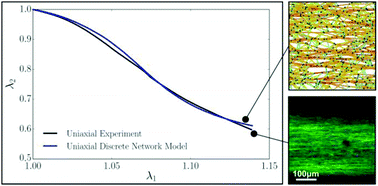Microstructure based prediction of the deformation behavior of soft collagenous membranes
Abstract
The response of human amnion (HA) and bovine Glisson's capsule (GC) to uniaxial and biaxial tensile loading is analyzed on tissue (∼mm) and collagen fiber (∼μm) length scales. The mechanical behavior of the membranes is rationalized based on a discrete fiber network model that relates model parameters with microstructural features of the tissues. Parameters were first determined for GC based on the quantity and organization of collagen fibers in the tissue. Next, parameters for HA were defined by comparing the microstructures of the two membranes, which differ in fiber organization in that collagen forms μm-thick fiber bundles in GC while 50 nm-thin fibrils constitute the network in HA. The flexural behavior of these structures is phenomenologically represented in the model, indicating that shear forces are transmitted through fibrils within GC bundles, but to a much lesser extent than in a corresponding solid cross section. The model provides excellent predictions of the uniaxial and biaxial mechanical response, as well as of the progressive reorientation of fibers associated with uniaxial loading. The results are particularly relevant since model parameters were not obtained through a fitting procedure of the tissue's tension–stretch curve. Furthermore, simulations of representative in vivo deformation states indicated that a large part of the fibers are expected to be un-crimped under physiological loading conditions. Thus, the crimped shape of collagen fibers in the initial test configuration, and typically observed in histological analyses, might be a consequence of the contraction occurring when membranes are extracted from their environment in the body.



 Please wait while we load your content...
Please wait while we load your content...